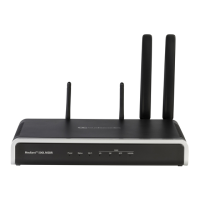User's Manual 20. Control Network
Version 6.8 289 Mediant 500L MSBR
Table 20-5: IP Group Table Parameter Descriptions
Parameter Description
Common Parameters
Index
[IPGroup_Index]
Defines an index for the new table record.
Type
CLI: type
[IPGroup_Type]
Defines the type of IP Group:
[0] Server = Used when the destination address, configured by
the Proxy Set, of the IP Group (e.g., ITSP, Proxy, IP-PBX, or
Application server) is known.
[1] User = Represents a group of users such as IP phones and
softphones where their location is dynamically obtained by the
device when REGISTER requests and responses traverse (or
are terminated) by the device. These users are considered
remote (far-end) users.
Typically, this IP Group is configured with a Serving IP Group
that represents an IP-PBX, Application or Proxy server that
serves this User-type IP Group. Each SIP request sent by a
user of this IP Group is proxied to the Serving IP Group. For
registrations, the device updates its internal database with the
AOR and contacts of the users.
Digest authentication using SIP 401/407 responses (if needed)
is performed by the Serving IP Group. The device forwards
these responses directly to the SIP users.
To route a call to a registered user, a rule must be configured in
the Outbound IP Routing table or SBC IP-to-IP Routing table.
The device searches the dynamic database (by using the
request URI) for an entry that matches a registered AOR or
Contact. Once an entry is found, the IP destination is obtained
from this entry, and a SIP request is sent to the destination.
The device also supports NAT traversal for the SIP clients
located behind NAT. In this case, the device must be defined
with a global IP address.
[2] Gateway = This is applicable only to the SBC application in
scenarios where the device receives requests to and from a
gateway representing multiple users. This IP Group type is
necessary as the other IP Group types are not suitable:
The IP Group cannot be defined as a Server since its
destination address is unknown during configuration.
The IP Group cannot be defined as a User since the SIP
Contact header of the incoming REGISTER does not
represent a specific user. The Request-URI user part can
change and therefore, the device is unable to identify an
already registered user and therefore, adds an additional
record to the database.
The IP address of the Gateway IP Group is obtained
dynamically from the host part of the Contact header in the
REGISTER request received from the IP Group. Therefore,
routing to this IP Group is possible only once a REGISTER
request is received. If a REGISTER refresh request arrives, the
device updates the new location (i.e., IP address) of the IP
Group. If the REGISTER fails, no update is performed. If an UN-
REGISTER request arrives, the IP address associated with the
IP Group is deleted and therefore, no routing to the IP Group is
done.

